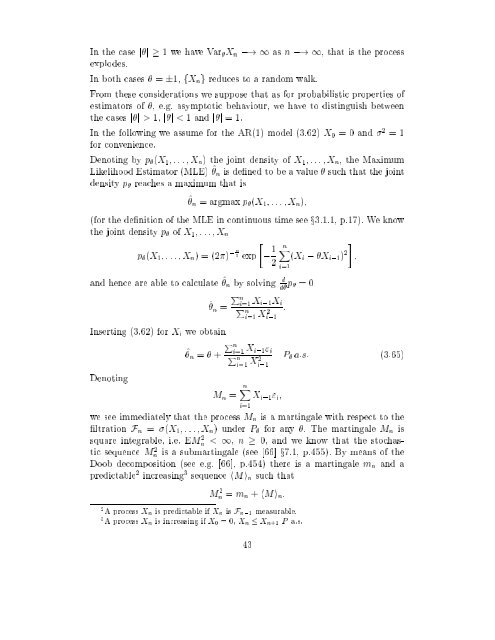Estimation in Financial Models - RiskLab
Estimation in Financial Models - RiskLab
Estimation in Financial Models - RiskLab
You also want an ePaper? Increase the reach of your titles
YUMPU automatically turns print PDFs into web optimized ePapers that Google loves.
In the case jj 1 we have Var X n ,!1as n ,! 1, that is the process<br />
explodes.<br />
In both cases = 1, fX n g reduces to a random walk.<br />
From these considerations we suppose that as for probabilistic properties of<br />
estimators of , e.g. asymptotic behaviour, we have to dist<strong>in</strong>guish between<br />
the cases jj > 1, jj < 1 and jj =1.<br />
In the follow<strong>in</strong>g we assume for the AR(1) model (3.62) X 0 = 0 and 2 = 1<br />
for convenience.<br />
Denot<strong>in</strong>g by p (X 1 ;:::;X n ) the jo<strong>in</strong>t density of X 1 ;:::;X n , the Maximum<br />
Likelihood Estimator (MLE) ^ n is dened to be a value such that the jo<strong>in</strong>t<br />
density p reaches a maximum that is<br />
^ n = argmax p (X 1 ;:::;X n );<br />
(for the denition of the MLE <strong>in</strong> cont<strong>in</strong>uous time see x3.1.1, p.17). We know<br />
the jo<strong>in</strong>t density p of X 1 ;:::;X n<br />
"<br />
p (X 1 ;:::;X n )=(2) , n 2 exp , 1 #<br />
nX<br />
(X i , X i,1 ) 2 ;<br />
2<br />
and hence are able to calculate ^ n by solv<strong>in</strong>g d d p =0<br />
Insert<strong>in</strong>g (3.62) for X i we obta<strong>in</strong><br />
i=1<br />
P ni=1<br />
X i,1 X i<br />
^ n = Pni=1 :<br />
Xi,1<br />
2<br />
^ n = +<br />
P ni=1<br />
X i,1 " i<br />
Pni=1<br />
X 2 i,1<br />
P a:s: (3.65)<br />
Denot<strong>in</strong>g<br />
M n =<br />
nX<br />
i=1<br />
X i,1 " i ;<br />
we see immediately that the process M n is a mart<strong>in</strong>gale with respect to the<br />
ltration F n = (X 1 ;:::;X n ) under P for any . The mart<strong>in</strong>gale M n is<br />
square <strong>in</strong>tegrable, i.e. EMn<br />
2 < 1, n 0, and we know that the stochastic<br />
sequence Mn 2 is a submart<strong>in</strong>gale (see [66] x7.1, p.455). By means of the<br />
Doob decomposition (see e.g. [66], p.454) there is a mart<strong>in</strong>gale m n and a<br />
predictable 2 <strong>in</strong>creas<strong>in</strong>g 3 sequence hMi n such that<br />
M 2 n = m n + hMi n :<br />
2 A process X n is predictable if X n is F n,1 measurable.<br />
3 A process X n is <strong>in</strong>creas<strong>in</strong>g if X 0 =0,X n X n+1 P a.s.<br />
43
















